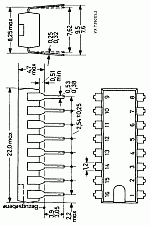
TCA240
|
|
|||||||||||||||||||||||||||||||||
|
Hits: 1378 Replies: 3
TCA240 function
|
|
|
Michael Watterson
22.Jun.23 |
1
It's actually a double-balanced-mixer of the "Gilbert Cell" type, similar to the MC1496, except that the two long tail pairs have separate bias pins and the carrier input pins are also separate. |
|
Michael Watterson
22.Jun.23 |
2
August 1976 data sheet, probably by Phillips: The TCA240 is a monolithic integrated circuit used for general purpose applications such as:
I have data for the MC1496, which was used in my 1975 Electronics course project, the TCA240 and the SA612A. I have all three parts in stock. Prior to these ICs either a ring diode mixer or a pair of 7360 Beam switching tubes was used as the transistor Gilbert cell really needs an IC. The main difference in function from the MC1496 and the SA612A is the ability to use it as a pair of simple differential amplifiers. All the other listed functions apply to any double-balanced mixer. The most recent mixers in a sense go back to the 1930 ring diode mixers (first implemented using copper oxide rectifiers on telephone trunk carrier systems) as they use four switches on a single chip. A more recent idea is to deliberately use aliasing on the sampling of an ADC, thus if the sample clock is 40 MHz, theory says you must input DC to 20MHz. But if you input 2300MHz that's band limited to 20 MHz, then the ADC acts as down-mixer. You can double the bandwidth by using two ADCs with the clocks out of phase by 90 degrees. This direct RF approach uses an ADC with a specially designed input. Later I may post some examples of all these mixers. |
|
Rudolf Drabek
13.Jul.23 |
3
This IC was a custom design within Philips for the N1500. The name was 343OM later TCA240. In this first modulator design the drive for the 343OM was unsymmetrical. Predev. was done in Eindhoven Tunerlab. Therefore to change the frequency was rather tricky to adjust the rest carrier to ZERO. Later I changed the drive to a symmetrical one so avoiding the problems changing the channel frequency around 600 +- 50 MHZ. I have some untested samples in the production frame of later versions. I think a foto is shown here earlier. philips: N1500 UHF Modulator mit N343 OM As I was the group leader at that time, 1971, we finished the development of the receiving part of tne N1500 in Vienna. Specially the FAFA = "phasenabhängige Feinabstimmung" via the soundintercarrier was part of the receiver, because it had to adjust the IF of the received channel to exact 38,9 MHZ. That was neccessary because of the unattended action of the receiver. At that early times there was no synthesizer tuner available.
|
|
Michael Watterson
13.Jul.23 |
4
I remember servicing N1500s for a Teacher Training College. Mostly mechanical issues due to being "dropped" onto the wheeled tables. About 1977. I remember they had electromechanical time clocks for unattended recording. Even the N1700 was being replaced then by VHS and Betamax, but people with a bigger budget had bought Sony U-matic rather than N1700. I've no idea where the apparently unused TCA240 ICs I have came from. I saw them in a parts drawer recently and looked them up as it was an unfamiliar part. |
End of forum contributions about this tube
| Data Compliance | More Information |




